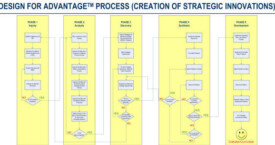The Strategic Innovation Methodology
Our solution to the challenge of creating and sustaining strategic advantage and growth is called Strategic Innovation Methodology.
What Is Strategic Innovation Methodology?
The Strategic Innovation Methodology is a robust step-by-step process, the purpose of which is to identify what and how has to be changed (hence Innovation) in the current competitive situation to gain a sustainable competitive advantage that would enable achievement of a chosen strategic objective (hence Strategic) such as growth, etc. In other words, it is a deliberate well-structured process aimed at engineering of competitive advantage, which is why it is also called Design for Advantage™ (or DFAd). It consists of 5 major Phases, with each of the Phases having their own objectives, inputs and outputs, containing multiple well-defined procedures, and employing robust tools and techniques enabling sequential achievement of the following results:
- Gathering of relevant information required for the analysis (Phase 1: INQUIRY)
- Comprehensive exploration of the existing Competitive Landscape and identification of value creation opportunities aka Value Voids (Phase 2: ANALYSIS)
- Identification those opportunities that have a strategic advantage potential and selection of the opportunities that have greater relevance to the predefined analysis objectives (Phase 3: DISCOVERY)
- Development of solutions that enable capture of the selected strategic opportunities and formation of what is defined as a Growth Platform (Phase 4: SYNTHESIS)
- Forecasting of the evolution of the Growth Platform resulting in the development of multiple supporting/enabling solutions, which leads to the formation of a Strategic Innovations Portfolio, the purpose of which is to enable sustenance of the strategic advantage (Phase 5: DEVELOPMENT)
You can download the methodology folding brochure that includes its roadmap by clicking on the thumbnail.
How Does DFAd Work?
Our 23-year research into the history of business successes and failures unequivocally shows that the difference between winners and losers is NOT that much in their abilities to solve problems effectively but in their abilities to identify the RIGHT Problems to solve.
Based on this finding, we firmly state that a perfect solution to the wrong problem creates no value and at the very least leads to losses. For example, the Blue Pepsi was perfectly blue and a nicely-tasting soft drink. Also, the Purple Ketchup by Heinz was perfectly purple and a ketchup. Finally, the Segway was a perfectly working transportation means. All of them shared the failure to address a meaningful problem for their respective customers, which is why they have one more common attribute – MARKET FAILURE! On the other hand, even an imperfect solution to the “RIGHT” problem can create growth, especially in the case when such a problem pursued by only one market contender. For example, the first sunroofs did not work perfectly, and the first IPhone had numerous performance flaws (such as brittle screen, miserable battery life, poor antenna, etc.), but the market recognized the problems that were solved by these products and awarded their creators with their purchases, thereby causing financial growth.
We define the RIGHT Problems as Meaningful (for the Customer) and Unique; i.e. no one pursues them for whatever reason. With the laser-like focus on discovering the RIGHT Problems, the Strategic Innovation methodology virtually guarantees creation of a Unique Value Proposition and automatically shifts the odds of gaining competitive advantage and generating growth in your favor. Identification of the RIGHT Problems is a prerequisite for creating growth.
Why Does DFAd Work?
Design for Advantage is rooted in the General Theory of Innovation (GTI), the only scientific theory of innovation with proven (see list of our clients and read their testimonials) prescriptive and predictive capabilities. The latter enables proactive and reliable identification of the RIGHT problems, i.e. long in advance of customers becoming aware of these needs and disclosing them to the world. This capability of proactively identifying Unique and Meaningful Problems reverses the odds of success to favor those who master the methodology “know-how.”
If you want to read more about the GTI-based Strategic Innovation methodology, please download our article Strategic Innovation.



